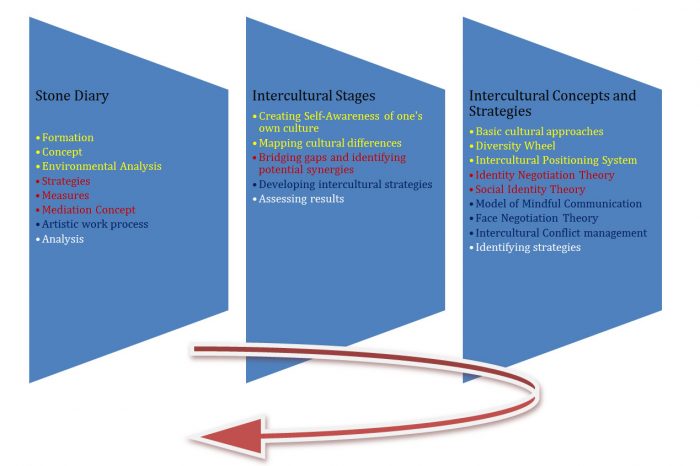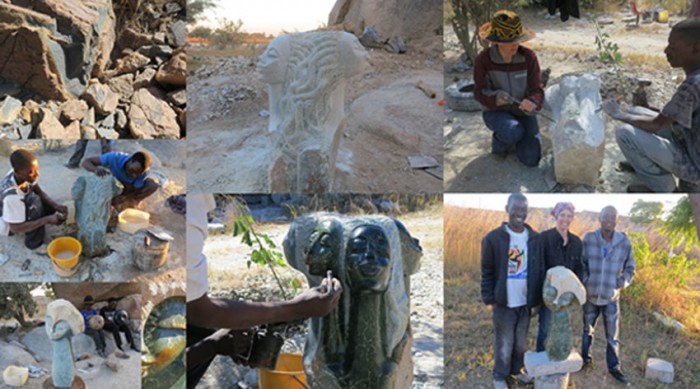Helga Palasser – Setting Intercultural Concepts to Work – the “Stone Diary” an art exchange between Zimbabwean and Austrian Sculptors
Helga Palasser’s professional education is twofold. She did a diploma in tourism economics and an apprenticeship in sculpture. In September 2010 Helga joined the programme for cultural production, where she is now working on her project .
As a sculptor with a strong interest in foreign cultures and creative art processes my research interest gave rise to my project idea and the research question. Personally, I have been motivated by a desire to know how an artistic intercultural exchange would work in practice. What happens when two artists having different cultural backgrounds meet? Are there any ways to facilitate this process and what intercultural differences would hinder the final outcome of the encounter?
The project which serves as a case study for my thesis is entitled the “Stone Diary” and will canvass an intercultural meeting involving an art exchange. It is an intercultural artistic collaboration of four sculptors, Allan Tapfumaneyi Tapfumanei, Rufaro Murenza, Liberty Tshuma from Zimbabwe, and myself from Austria. This artistic project starts with a personal exchange of artistic knowledge and the creation of works of art related to our life-stories, with the topic “faces and places“. These will be documented in an artbook, which will serve as an advertising tool for the stone sculpting workshops combined with a travel to Africa. The workshops take place annually at the Chitungwiza Arts Centre and will be a fabulous opportunity for a public with a particular interest in art to learn about this unique kind of sculpting.
Accordingly the research question was:
- How can an artistic cooperation between an European and a Zimbabwean artist be developed in an interculturally sensitive way: The case study “Stone Diary”?
Sub-questions:
- To what extent will cultural differences affect our collaboration?
- In what ways can this cultural encounter be fostered in order to be rewarding for both parties?
The main research aim is to offer new perspectives on intercultural competence with a particular focus on how intercultural sensitivity including its challenges and possibilities can be developed in a personal and process-oriented way. To realise this aim my research work will be supported by practical experience. From the scientific perspective I intend to apply concepts from the field of intercultural competence and communication concepts, as well as an artistic endeavour with the help of project management methods. In addition, I hope to illustrate the problems and possibilities of our artistic collaboration and find ways to facilitate artistic co-operations between different cultures.
Aims of this undertaking are the following:
- to experience intercultural exchange on a personal level
- initiate new artistic and cultural growth
- to explore the differences and similarities that come out of this process
- to spark interest in other cultures
- making people visible through the creative art process
- to develop partnerships
- to establish a community with a particular interest in intercultural processes
- to address the misconceptions we often have towards other cultures
- to promote intercultural dialogue through personal experiences as an artist
- to raise dialogue on integration, racism and policies concerning culture
Summary of the investigation process:

Figure 1: Summary of the investigation process concerning finding ways to develop the project “Stone diary” in an interculturally sensitive and competent way. (The middle part: “Stages of building culturally diverse teams” from Varner and Beamer (2011: 466) adapted by Palasser (2012)
The figure below is a pictorial summary of steps I have taken in answering the research question. I have used a colour coding system to indicate the stages where a given intercultural strategy is most applicable – e.g. using the diversity wheel and the intercultural positioning system for building awareness in the start-phase of the project, followed by strategies like the identity negotiation theory to explore the subject in depth and recognize the connection between these areas.
Supervisors:
Birgit Breninger
Elke Zobl/Florian Bettel
Form of presentation/documentation:
The artbook “Stone Diary” will be available soon, a slideshow/documentation of the artistic process is online: www.palassart.com
Link to presentation/documentation:
www.palassart.com/?p=427
Cooperating Institutions:
Chitungwiza Arts Centre
Cooperating Artists:
Allan Tapfumanei
Liberty Tshuma
Rufaro Murenza
Helga Palasser
Elke Zobl, Elisabeth Klaus ( 2012): Cultural Production in Theory and Practice. In: p/art/icipate – Kultur aktiv gestalten # 01 , https://www.p-art-icipate.net/cultural-production-in-theory-and-practice/


